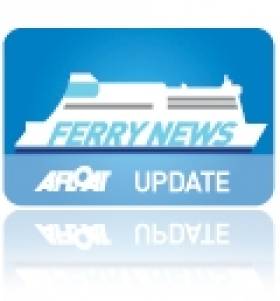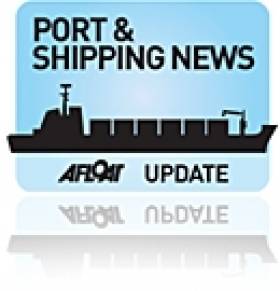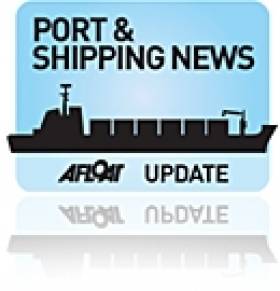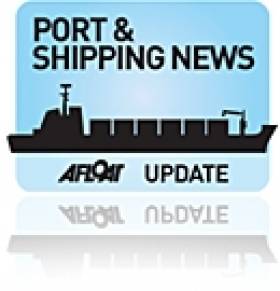Displaying items by tag: FastFerries
Fast-Ferries Prepare to Resume Seasonal Service on the Irish Sea and Isle of Man-UK
Fast-ferries of the Irish Sea which number just two, are currently berthed in Belfast and Birkenhead, from where works are been carried out to prepare both craft in advance of seasonal services in the spring, writes Jehan Ashmore.
Irish Ferries high-speed craft, Dublin Swift is at Harland & Wolff’s Belfast Dry-Dock for routine annual overhaul. The 2001 built craft had arrived last week from Liverpool, having been in lay-over mode during the winter months on Merseyside.
Afloat has consulted the operator’s website booking system which sees the first fast-ferry crossing on the Dublin-Holyhead scheduled on 10th March, a week in advance of the St. Patrick’s Day bank holiday weekend.
The Ireland-Wales link is just 1 hour 35 minutes crossing time and runs in tandem with the conventional ferry time of 3 hours 30 minutes. As for passenger (fast-ferry) facilities they include a brasserie, TV lounge, a shop, games zone and free WiFi is available.
On the other side of the Mersey, the Isle of Man Steam Packet’s 1998 built craft, Manannan is at Cammell Laird undergoing maintenance and a partial refit while at the shipyard’s wet basin in Birkenhead.
Also occupying the basin is Stena Europe as Afloat reported previously, the Rosslare-Fishguard ferry which is undergoing repairs following an engine-room blaze. Noting sailings are suspsended until 26th February, just day's before St. David's Day on 1st March.
As for Manannan's return to duties, this is due to take place on 23rd March, but firstly to cover Douglas-Heysham sailings otherwise routinely carried out by the main ferry, Ben-My-Chree which is to have its annual maintenance in Cammell Laird.
The dry-docking of the 'Ben' is take place between 23-31 March, however this has been brought forward to ensure the ferry provides a more resilient and reliable service during the main busy season, as the delivery of the newbuild Manxman is delayed. The reason follows sea-trails where problems arose with a faulty gearbox which led the new ferry to return to the ship’s Asian shipyard.
Seasonal high-speed craft services between the Manx capital and Merseyside, will see Manannan resume scheduled daily sailings between Douglas and Liverpool landing stage on 31st March.
This fast-ferry operated route takes 2 hours 45 minutes. On board there is seating areas and those comprising of three lounges based on reserved, premium and executive club categories. In addition to two cinema lounges, a bar area and cafe.
Afloat will also have more on the Steam Packet's fast-ferry seasonal routes of Dublin-Douglas and Belfast-Douglas.
Cancelled Sailings: Irish Ferries 'Fast-Ferry' Operated Sailings
#CancelledSailings – Certain fast-ferry operated sailings on the Irish Sea today and for tomorrow (Tuesday 26 September) are cancelled due to adverse weather conditions.
Irish Ferries have cancelled tomorrow's fast-ferry only operated sailings otherwise served by Jonathan Swift on the Dublin-Holyhead route.
Instead all passengers are to be accommodated on the alternative cruise-ferry Ulysses which will be operating to service as normal. For further information on sailing times consult the Irish Ferries website HERE.
As the Autumn season is underway, any further disruption to sailings can also be consulted on the 'AA website' which provides daily updates and contact details of the various travel operators by 'scrolling down' their website page HERE.
Manx Seasonal Visitor to Dublin Port
Following this mornings Irish route sailing, she resumed on her regular Douglas-Heysham route and she also serves Douglas-Birkenhead (Liverpool) during the winter months.
During the summer Dublin-Douglas sailings are served by fast-ferry catamaran Manannan (1998/5,743grt). The 96m InCAT built in Hobart,Tasmania had also operated Douglas-Belfast high-season crossings. Her roster is now confined to a Douglas-Liverpool sailing schedule.
Ben-My-Chree (photo) is Manx for 'Girl of my heart' and her island owners commissioned the 12,504grt ro-pax from Dutch shipbuilders Van de Giessen-de Noord. The 125m ferry was launched in 1998 and she can accommodate 630 passengers,275 vehicles and 1,235 freight lane-metres.
This particular ro-pax design has also been built for Channel Islands operator Commodore Ferries with their Commodore Clipper and a Scandinavian ferry operator. In addition another Dutch shipbuilder, Merwede built a multi-support vessel (MRV) derived from the design of Ben-My-Chree for the Royal New Zealand Navy when they commissioned HMNZS Canterbury (L421). Click for similar port-side photo view to compare differences.
Incidentally the Manannan prior to entering service last year for the IOMSPCo. was for five years chartered initially to the United States Navy but transferred to the United States Army Forces. To read more click HERE.
Irish Sea Cross Channel Fast-Ferry Services On Declining Trend
The third service between Belfast-Stranraer is in the hands of rivals Stena Line which maintain the HSS Stena Voyager (1996/19,638 grt) on sailings but only to around mid-November. She will be replaced by conventional sister-ships which will be introduced on the North Channel's newest port when services switch from Stranraer to a new terminal close to Cairnryan.
Finally the fourth fast-ferry is Irish Ferries marketed 'Dublin Swift' service which runs on the Dublin-Holyhead route served by Jonathan Swift (1999/5,989 grt). The craft built by Austal in Fremantle, operates alongside the conventional cruise-ferry Ulysses.
Stena Line's decision to terminate HSS Stena Explorer sailings between Dun Laoghaire-Holyhead this day last week follows fast-ferry Stena Lynx III's end-of-season Rosslare-Fishguard sailings earlier this month.
From next year, Dun Laoghaire-Holyhead sailings are to be seasonal-only and according to Stena Line they hope to resume fast-ferry sailings in April or May though no exact date has been set. Unlike the central corridor route which was entirely dependent on HSS operations, the Rosslare-Fishguard route remains operating year-round with the conventional ferry Stena Europe.
As a result of the discontinued fast-ferries, the HSS Stena Explorer is now spending a lay-up period in the Welsh port for the winter. The smaller Stena Lynx III is also 'wintering' but in on the opposite side of the Irish Sea in Dun Laoghaire, where the vessel has done so in previous years.
The lay-up of both fast-ferries in Dun Laoghaire and Holyhead is ironic considering that neither ports' are connected by the very craft that used to share sailing rosters in recent years. In addition the wintering of these catamaran craft is the first time that this has occurred since the pioneering Stena Sea Lynx fast-ferry launched such sailings in 1993.
This first 'Lynx' provided seasonal sailings on the route with conventional car-ferry Stena Hibernia, the former St. Columba, custom-built in 1977 for Sealink /British Rail. She was given a second name under Stena ownership, the Stena Adventurer and remained on the 57 nautical-mile route until replaced in 1996 by the year-round operated HSS Stena Explorer.
Apart from cross-channel fast-ferry services, the Isle of Man is served by the Isle of Man Steam Packet Co. Ltd's routes linking the islands capital Douglas with Belfast, Dublin, Heysham and Liverpool (Birkenhead) in the winter. These routes include seasonal services which are operated by a combination of conventional tonnage using Ben-My-Chree and fast-ferry Manannan (1998/5,089grt), a former US Navy vessel, to read more click HERE. For sailing schedules, vessel type deployed on route and for fares click HERE.
- Dublin Port
- Irish Ferries
- Dun Laoghaire
- Stena Europe
- Holyhead
- P&O Ferries
- Belfast Harbour
- Stena Line
- Larne
- Ports and Shipping News
- Ulysses
- P&O (Irish Sea)
- Cairnryan
- Ferry news
- Stena Explorer
- Stena Express
- FastFerries
- Cruiseferry
- Manannan
- Isle of Man Steam Packet Co.
- Stena Voyager
- Belast Port
- Isle of Man ferry services
- P&O Express
- Irish Sea fastferries
- Stena 'Lynx'
- BenMyChree
- Dublin Swift
- Stena Sea Lynx
Mauritius-Bound Ferries Finally Bid Galway Farewell
First to be loaded was the Clann na nOileáin on Wednesday in an operation than took four-hours while on Friday her sister Clann Eagle I took six-hours to be winched safely onto the cargo-deck during freshening winds.
It is ironic that since Thor Gitta 's arrival to the port's Dún Aengus Dock on 5 April that it would also nearly be the same time taken for the estimated 25-day delivery voyage of the ferries to the Indian Ocean island.
During the 8,300 mile journey Thor Gitta will make several port of calls with the first call to La Rochelle. The Bay of Biscay port is the next largest port south of Les Sables d'Olonnes, where the fast-ferries where built at the OCEA boatyard for her original owners Bád Arann Teoranta which traded as Aran Direct on routes from Rossaveal to the islands.
Thor Gitta was built in 1996 and is also designed to carry 364 TEU (twenty-foot equivilant unit) containers and belongs to an-eight strong fleet operated by the Danish company, Thor Rederi A/S of Svendborg.
One of the reasons why the heavylift vessel was delayed in loading was to ensure the correct positioning of the ferries so not to further disrupt other port call cargo allocation while on the long repositioning voyage to Mauritius.
The 4,078 tonnes cargsoship is also scheduled to make en-route calls to Pointe Noir in the Congo, Cape Town and Pemba in Mozambique before finally reaching the southern Indian Ocean destination.
When the ferries were completed in 2005 and 2006 they were valued between €5-6m but they only served up to September 2008 when the 243 passenger aluminium built craft were laid-up at the Connemara harbour due to financial difficulities.
This led to the company going into receivership and the vessels were put up for auction in Galway last February. Despite bids reaching €950,000, they were withdrawn at the auction hosted by the Cork based auctioneer, Dominic J. Daly.
In the following month the fast-ferries were sold to the French owner for a new career based from the island state which is in the Mascarene Islands. Mauritius is neighboured by the smaller islands of Agalega, Cargados Carajos, Rodrigues and the French island of Réunion some 200km to the southwest.
Ferry-Tales of the Unexpected Continue in Galway Docks Drama
Despite successfully loading the first ferry, the 172 gross tonnes ferry Clann na nOileain yesterday morning, which took four hours, the time to secure the vessel on the cargoship's deck continued much longer than anticipted.
As a consequence this led to further delays in the the clearance of existing cargo so to enable sufficient space to load the second ferry onboard the Thor Gitta.
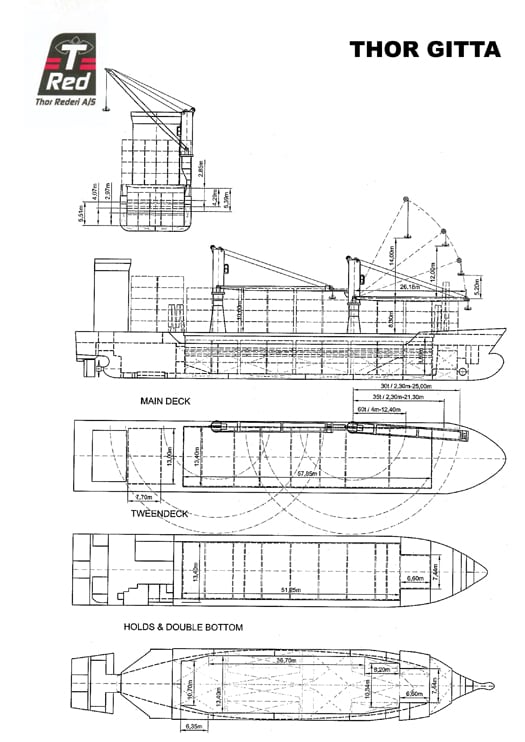
The 4,078 gross tonnes heavy-cargo liftship was due to have started loading the second ferry the 169 tonnes ferry Clann Eagle I yesterday afternoon but this has been delayed until 12 noon today.
The Danish-flagged Thor Gitta has been in Galway for over a fortnight. She berthed with her starboard side facing alongside the quay. With this orientation the cargoship's two-deck mounted cranes swing out on the opposite port side which were used to raise the first ferry out of the water on 7 April.
On that ocasion the forward sling snapped causing the Clann na nOileain to plunge into the waters within the port's single dock named the Dun Aengus Dock.
In recent daysThor Gitta has shifted berths which has resulted in the 100m long vessel berthing on her starboard side again next to the dock's quayside. The deck-mounted cranes on the port side continue to face out overlooking the open water of the dock.
The loading of Clann na nOileain is all the more skillfull considering that the 27m length of the ferry had to be hoisted and swung at an angle between the narrow span of the two deck mounted cranes.
For file photos of vessels in loading mode from the Rederi A/S fleet owners of the Thor Gitta click here.
Thor Gitta is the second chartered vessel called in to assist in the transportation of the two former Aran Islands fast-ferries.
The other cargoship, the longer 120 metre Patanal, ran aground at the end of March during stormy seas after dragging its anchor in Casla Bay, at the entrance to Rossaveal harbour. The 7,002 tonnes vessel sought initial repairs before leaving Galway Bay last week for further work in Germany.
The monuhull fast ferry pair were custom built in France for Bad Teoranta (trading as Aran Direct) but the company went into recievership.
At an auction held in Galway last month the vessels did not sale despite bids reaching €950,000, they were withdrawn at the auction. The ferries were later sold for a sum believed to be seven-figures to an operator based in the Indian Ocean island of Mauritius.
First of Two Ferries Loaded in Galway
The Clann na nOileáin was first loaded onboard this morning whereas her sister Clann Eagle I will be hoisted this afterrnoon. It is expected that this procedure will take around four hours to complete.
The 234-passenger ferries have been the centre of attention since two previous attempts proved unsuccessful following incidents in the mid-west port.
On the first attempt that took place nearly a fortnight ago, three men onboard the ferry were injured when the ships's crane-sling snapped when handling the 170 tonnes ferry Clann na nOileáin.
Fortunately the ferry was hanging over the water and splashed into Dun Aengus Dock rather than landing on the hold of the 4,078 gross tonnes cargo-vessel Thor Gitta. In the second attempt last
Saturday one of the cargoship's cranes sounded a safety alarm which halted proceedings.
The Danish-flagged Thor Gitta is the second heavy-lift cargoship that has been called in to assist in transporting the two former Aran Islands fast-ferries. The 100m cargoship is owned by Thor Rederi A/S of Svendborg and is expected to depart Galway tommorrow morning.
The first heavylift vessel the German-flagged Patanal grounded in rough seas after dragging its anchor in Casla Bay at the entrance to Rossaveal, where the ferries were originally based in readiness for loading.
Patanal suffered hull damage and was taken into Galway Bay for preliminary repair work. Last week the 7,002grt vessel operated by Harren + Partners, departed the bay to undergo further repairs at a dry-dock in Bremerhaven.
Ongoing Ferry Saga As Cargoship is Detained
Harbourmaster Capt. Brian Sheridan, confirmed yesterday evening that the Danish flagged vessel had been detained at lunchtime on the instructions of the admiralty marshal, a High Court judge, acting under maritime law. Until matters are resolved, a ship's keeper has been placed onboard by the Revenue Commissioners.
Cargoship to Attempt Second Ferry-Lift
In the first attempt to load the ferries last week, the Clann na nOileáin fell into the Dun Aengus Dock when the sling rope broke causing the French built 234-passenger craft to fall some 12m /40ft. Onboard the ferry were three people who were taken to hospital but were later released.
Thor Gitta is fitted with two deck-mounted cranes and this feature is also similarly found on the Patanal, which grounded in Casla Bay at the entrance to Rossaveal, nearly a fortnight ago. The German owned 7,002grt was the first vessel chartered to bring the fast-ferries from Rossaveal, but the ferries were subsequently sailed to Galway after the ship was refloated.
The 120m Patanal has undergone "underwater and internal inspections and repairs," according to Capt. Brian Sheridan, harbourmaster of Galway Port Company though he added "that the vessel would remain subject to an inspection by the Marine Survey Office before she can be released".
According to a statement released by the Patanal's owners, Harren & Partner, the vessel is then to be taken to dry dock in Bremerhaven for further repairs.
Since the incident the vessel has been at anchorage off Black Point on the Co. Clare side of Galway Bay where she was monitored initially for pollution and the tug Celtic Isle in attendance. The tug is operated by Celtic Tugs and is normally based in Foynes, Co. Limerick.



























